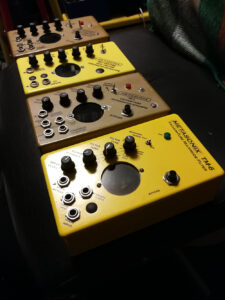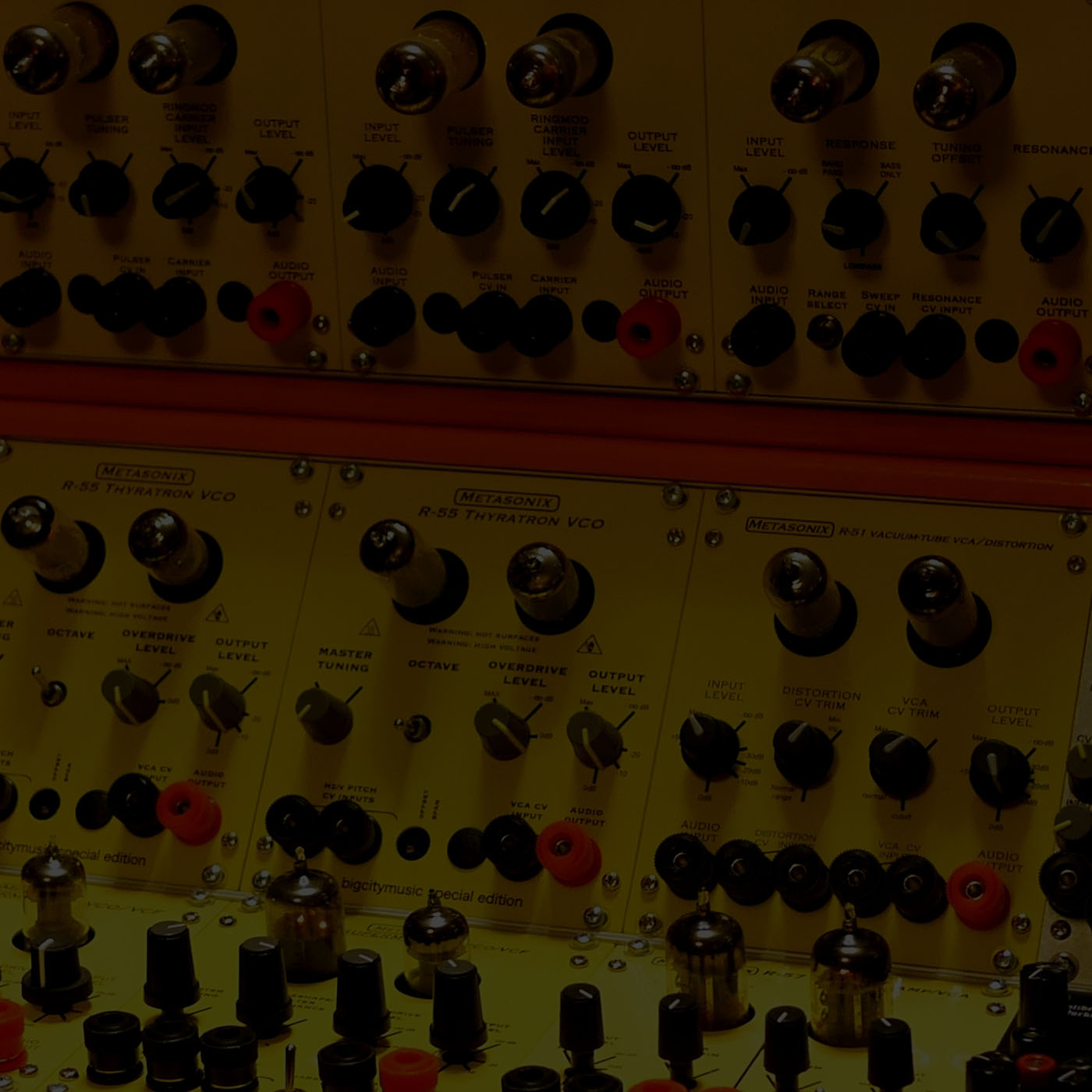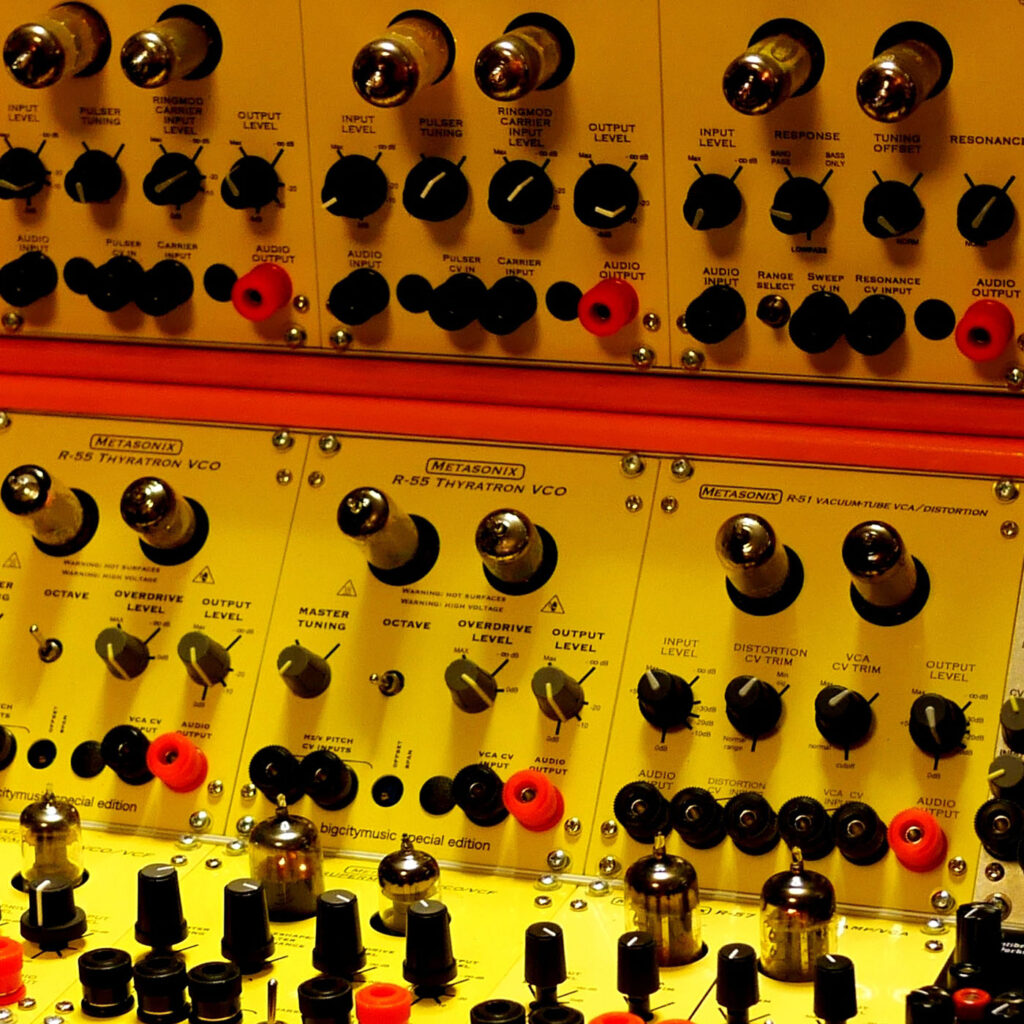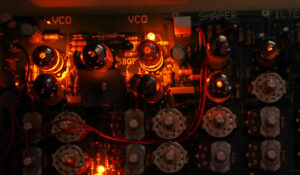
In late 2000, as an Associate Editor at Electronic Musician magazine, I had the opportunity to review the TS-21 Hellfire Modulator, from a relative new comer, Metasonix. Unlike other companies who were jumping on the tube-based bandwagon for marketing reasons, Metasonix’s founder, Eric Barbour, based his entire designs around vacuum tubes, specifically ones that were not designed for audio use. Non-linearity was the whole point, and it was easy to hear how musically useful the TS-21 was as a source of indeterminate sound generation and audio processing.
A few months later, I included Metasonix in a feature on “modular” synths because, by then, the company had four items in its catalog—the TS-21, the TS-22 Pentode Filterbank, the TS-23 Dual Thyratron VCO, and the PT-2 Tubestation monosynth. Each one of these items, like everything Eric has released since then, stood out in terms of sound and functionality. His modules have attitude.
Compared to today, the choices back then were few, though solid. In April 2001 when my round-up hit the streets, there was no overwhelmingly dominant modular format: Frac-rack was popular through Blacet; 5U was holding steady thanks to Synthesis Technology/MOTM and Synthesizers.com; Grant Richter was deep into Wiard Synthesizer Company and had a hand in the badass little Evenfall Mini Modular; and Bob Moog was designing a new modular disguised as stomp boxes. Meanwhile, Serge STS, Modcan, Technosaurus, Analogue Systems and Analogue Solutions were bustin’ ass. And, of course, Doepfer’s catalog was growing by leaps and bounds in the pre-dawn of the Eurorack craze.
Two decades later, and even with a few copy-cats out there, Eric’s line remains in a class all its own. The world of Metasonix has only gotten more unruly, rebellious, and rowdy over the years but, like a good biker bar, its a fun place to spend time if you’re tough enough to stand your ground. As you’ll hear, these yellow modules have plenty to say through these artists, and vice versa. So put yer quarter in the slot and let’s go!
Intro text by Gino Robair / Pictures : Palle Dahlstedt
Questions from Philippe Petit // Replies = Ric Barbour
Where, when and how did you first become acquainted with modular synthesis?
More than 40 years ago, in college. Built my own gear because couldn’t afford what was available. The real price of gear has DECLINED since 1975–drastically.
Younger people don’t realize how different it was back then.
Once you said :
“It is a field for crazy, irrational people, no-one should start a company manufacturing modular synth there is too much competition already.”
How do you deal with competition?
Metasonix has existed since 1999. We have enough serious fans now that the extreme saturation of the Euro market doesn’t affect us very much. We do very little advertising and don’t attend trade shows anymore.
In fact, the Covid shutdowns this year were great for our business. People are stuck indoors so they are buying more music gear than ever (if they can get it).
Metasonix has been around so long that other companies are starting to imitate us. A few Euro makers have put out tube modules, albeit not very original ones. It is routine to make either a solid-state module with a 12AX7 added for distortion, or a simple VCA with a pentode.
And don’t forget the “Knifonium” from Finland. An all-tube synth with two VCOs and a Moog-like ladder filter. It came out in 2012. It’s a very nice conventional-sounding monosynth, but horribly expensive.

What motivated you to become an electronic circuit designer? Is circuit design a natural extension of composing for you? Are you in some ways a “macro-composer” when you design tools that composers use to compose?
I have a BSEE degree. And 30 years of experience with vacuum tube electronics, which required me to educate myself in the field. I was also senior editor of Vacuum Tube Valley magazine for its entire 10-year run.
Being self-employed with my own business and customers, in a CREATIVE field, is far superior to working for US defense contractors or marginal tech companies. Been there and hated it. I’m too old to get a conventional job in the field now anyway.
Do you compose or perform music — or don’t you have time to do so?
Not since the 1980s. I helped out a couple of (failed) bands by playing synth or running sound. Getting enough attention is very difficult. No matter the style, there are always far more musicians than venues to play at or other opportunities. The heavily saturated Euro module business is just “average” compared to the massive oversupply of musicians. California is completely insane. I’ve heard rough estimates that there could easily be 500,000 amateur and pro musicians here.
Your original graphic design + using vacuum tubes is unique in the synthesizer world, once you said:
“There’s nothing more evil than a vacuum tube, trust me. Noisy, erratic, they do bizarre things at bizarre times…”
This would be my description of the Synthi AKS I use, was that an influence?
The only Synthi I ever spent time with was the one at my university. In the late 1970s. And it was not working properly and they refused to pay to fix it. So I built my own solid-state synth from scratch (it fell apart and was discarded long ago, sorry to say).
There were almost NO voltage-controlled synthesis devices using tubes, at all, until I started Metasonix. Things like the Univox, Solovox, or Ondes Martenot were not the same as a “synthesizer” as defined since the 1960s. And please don’t mention the Hammond Novachord. It was simply a top-octave electronic organ with primitive control over note attack and decay. It did great string sounds and passable organ and piano-like tones, and not much else. Sweepable filters didn’t exist until Moog and Buchla started offering them.
I saw a void and decided I could fill it. No one had ever tried before. It was wide open and totally ignored by the “extreme synth nerd” scene, who are too conservative and conformist anyway. Started experimenting with the first breadboards around 1995. There was also no “prior art” to copy or use so we had to devise all the circuit designs virtually from scratch. At most I obtained a few ideas from schematics found in 60-plus-year-old textbooks. No patents to worry about–they all ran out long ago.

Which pioneers of modular synthesis influenced you, and why?
Buchla?!
Nope, could not afford Buchla in the old days.
I owned a mishmash of monosynths prior to the 1990s. What I’m doing now is self-influenced. It does what it does, and you either find a musical use for it or not.
You chose to use the Eurorack format for commercial reasons though you just adapted one module to the Buchla format. Why?
For years a few people have been begging for Serge and Buchla versions. I finally found the time in late 2019. Whether the fans in those areas like it or not, those formats sell a LOT more slowly than Euro. Our Buchla-compatible module is just three RK modules on a panel, with a special power cable. Far easier than devising a new PC board and mechanical layout for something that sells only a few pieces per year.
Banana or mini? Size aside, what is your favorite plug? Is it an issue of sonic quality, patching ease, going with the flow?
Bananas or 1/4″ phone connectors would be preferable for reliability. But you have to make what the largest number of people will accept. For the last 15 years Eurorack has totally dominated it.
Have you ever seen Kilpatrick’s module format? It’s genius. Easy to use, consistent. But there just is not enough interest in the scene.
What was the most influential design for you; the one that made you want to create your own designs?
Nothing to really point at directly. Even in the 1970s there was so much on the market you could not choose.

Vacuum tube were crucial in originating Electronics, would you tell us about their inception/evolution in history and what made you chose them?
It was DEAD technology by the time I got interested around 1990. Most American tube factories were torn down in the late 1980s or early 1990s. But I realized tube electronics were catching on again in audiophile equipment. That was when Glass Audio magazine started. One thing led to another, I wrote some items for GA, then ended up working for a company in Sunnyvale, then Charlie Kittelson started Vacuum Tube Valley and asked me to help out.
A big step for you was creating the Agonizer telling people « Now Suffer » which obviously may sound seducing for some of us and repellent for many… In real you grew up with Punk/HC, being subversive and enjoy to piss people off?
Of course. Why not piss people off? So much of the music gear business is “autistic” and “conformist”. Go and look at the old Analogue Heaven mailing list community to see some really rigid little minds.
The Agonizer was incredibly effective at getting attention. Being a “serious manufacturer” isn’t enough, you have to bash people over the head to get their attention. It was bad in the early 2000s, but I swear it’s only getting worse today.
You are interested in innovation, new sounds thus what does inspire a new module design?
Look through a 1960s or 1970s tube manual. It contains hundreds of weird things made for TV sets or industrial equipment. No one (I MEAN NO ONE) ever thought of making audio processors with them. The RK2 is a perfect example: a 15LE8 “dual pentode” thing meant as a color matrix decoder for TV sets. Horrible piece of crap but why not make a VCA/distortion out of it? Or the 6Z10 in the Agonizer which was meant to be the FM sound circuit for a really cheap television set.
I could make more “new devices” easily. The main issue is time, energy (getting old), money, and my ability to secure adequate supplies of the tube involved. Most tubes have not been made since the 1980s and will never be made again, period. So the market size is limited. I have NEVER used current production tubes and won’t if I can possibly help it; the market is dominated by 12AX7s and 6922s. Neither of which are really suitable for wild experiments. I have contacts with dealers having millions of “new old stock” tubes but even they can’t provide everything I could find useful.
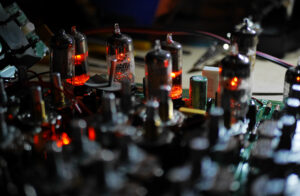
Is there a type of module that you would like to build, but that is too expensive (or doesn’t have a big enough audience to support making it)?
Some folks keep asking for a Moog-style ladder filter. The Knifonium has one. It is not difficult to implement with tubes, but it is VERY large and will consume a tremendous amount of power. Not suitable for a modular synth. Especially not in Euro format. I’m trying to make usable circuits with as few tubes as possible. Power supplies in Euro cabinets are usually a joke. Chase the “low end” of the market and this is what you get.
You should be amused that the Knifonium costs $16,000 and basically sounds almost exactly like a two-oscillator Moog. That makes someone like Hans Zimmer happy, but I’m not interested in imitating anything that existed before.
What has been your most popular design (or designs), and why do you think it (or they) became so successful?
The “broken pulser” circuit in the TS-21, TM-1, R-53 and RK3 has been very popular. It is a totally unique device and never existed before. Especially not in tubes. Thyratron VCOs are unique and don’t sound like any solid-state gear; it will probably take another 10-20 years for people to realize this.
In general people don’t know what they want other than what existed before; if not for musicians seriously looking for new and unique sounds, like Trent Reznor, Depeche Mode, DJs like Deadmau5, and a few others, this “business” would have been hopeless. You put out something totally new and see if it finds an audience. Music is very conservative but there are enough people looking for novelty that it can keep us going. I don’t make audiophile equipment; that is a FAR tougher and more conservative market.
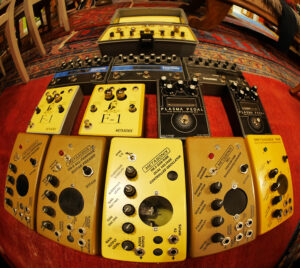
Do you feel close to other makers and/or designers? If so, which ones?
Not really, but I have some enemies who have stabbed me in the back on a few occasions. Can’t really tell you more. Those fine folks are STILL hanging around today.
What have you been working on lately, and do you have any upcoming modules?
We have been buried with work and other problems this year. Remember that I live in California wildfire country. This summer we have gotten constant warnings of fire conditions, filthy air due to nearby fires, and threats by PG&E to shut off the electric utility power. Hopefully I can get time this winter to develop something new.
